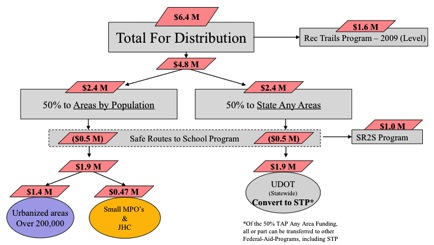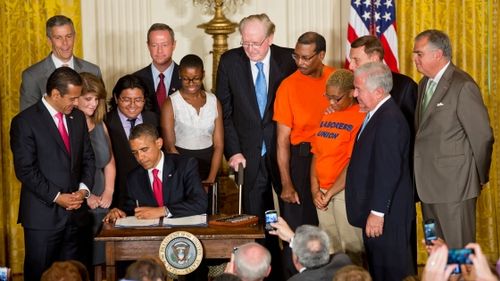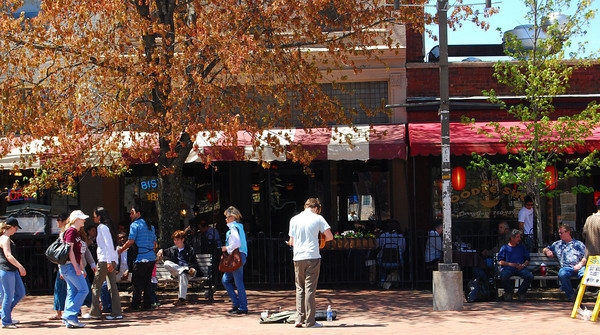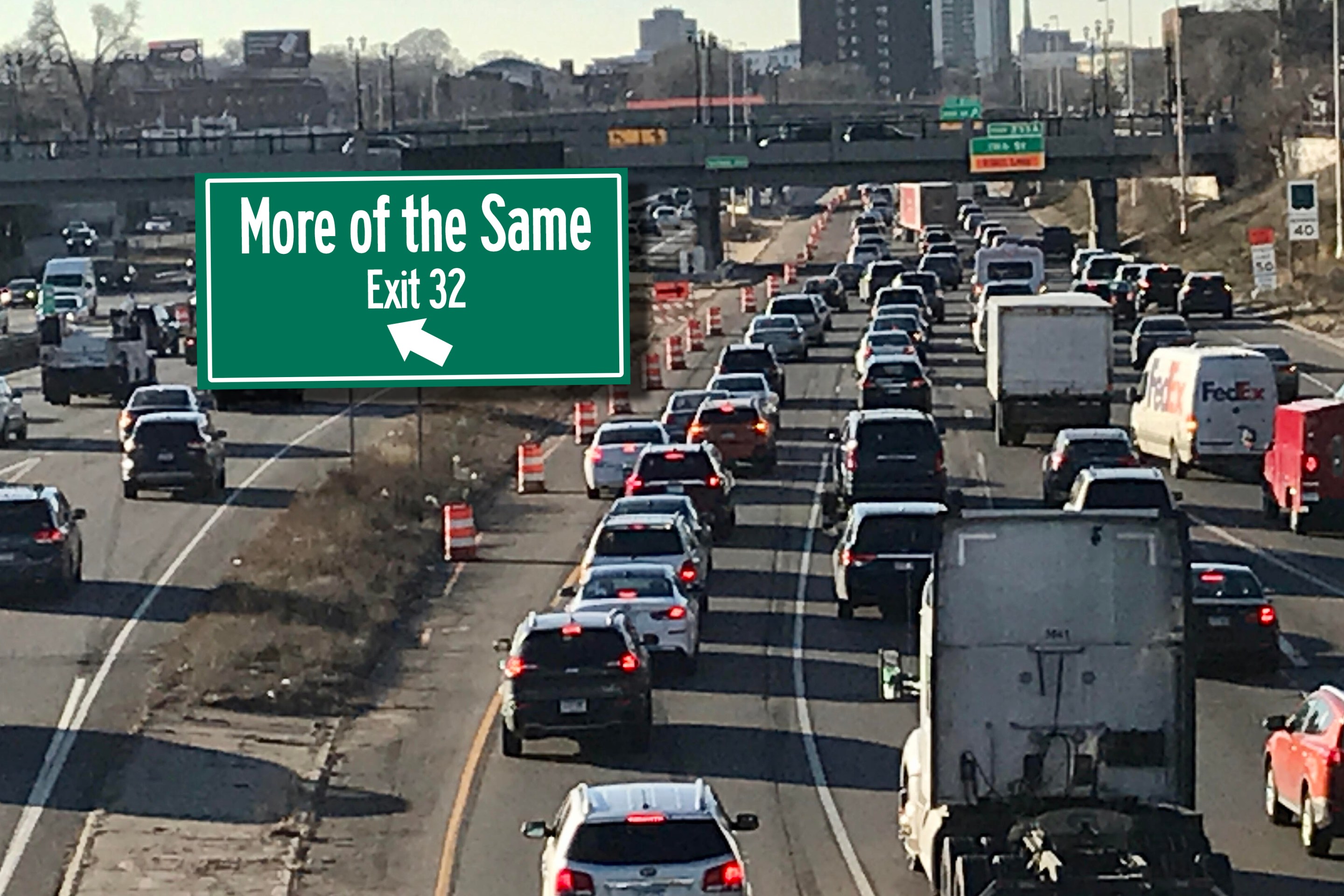
The current transportation law dealt a few hard knocks to bicycling and walking programs. One big one was the restructuring of the Transportation Enhancements program into something called Transportation Alternatives, which has to fund more types of projects with less money.
The idea is that each state’s TA money will get split in half. Fifty percent gets allocated to Metropolitan Planning Organizations (MPOs) and Transportation Management Areas (TMAs) based on population. Let’s call that the “Local 50.” Then the state gets the other half – the “State 50” – and is supposed to distribute it via a competitive grant process.
Local 50: It's not quite 50
The first thing to know is that even the Local 50 isn’t always entirely under local control. The Local 50 gets distributed according to population to whatever entity represents each area. For large metro areas and sometimes even small urbanized areas, there’s an MPO or TMA in charge. But for rural areas, sometimes it’s just the state that runs things.

Take Michigan, for example. The state is looking to get $26 million in Transportation Alternatives funds. Of that, $2.9 million comes off the top for Recreational Trails, a separate program with its own money (raised from off-road vehicle fees) that’s administered by the Department of Natural Resources, not MDOT.
That leaves $11.6 million each for the Local 50 and the State 50 in Michigan.
About $6.5 million of the Local 50 will go to the TMAs in jurisdictions of more than 200,000 people. But the rest of the money -- over $5 million from that supposedly “Local” 50 -- goes to the state to distribute.
That’s before you even get to the half that the state is supposed to control.
This is how the Cardin-Cochran amendment is being interpreted on the ground. The amendment was a creative and hard-fought way to make sure that some TA money actually went to the sorts of projects the old Transportation Enhancements program used to fund – primarily bike and pedestrian infrastructure, plus some safety education.
State 50: A short window to start funding bike/ped projects a new way
Now, on to the State 50. States are supposed to set up a competitive grant process to distribute those funds. It may seem like a large burden for states to set up a process like this for a law that expires in two years, but Tracy Loh, who runs the National Transportation Enhancements Clearinghouse, said that most states already had a similar grant program, so they don’t have to create one out of whole cloth.
“For most states, it’s simply a matter of adjusting the eligibilities to match MAP-21,” Loh said. “In many states, it’s business as usual – with less money, of course.” Transportation Alternatives suffered a roughly 33 percent cut in funding in the transition from TE.
“Some states have more work to do than others on refreshing their programs,” she added.
The only states that don’t have any such program, Loh said, are Alaska, Arkansas, Idaho, Kentucky and Oklahoma.

That’s not to say that states with existing programs see this as an easy task. Michigan already has a fairly sophisticated grant process, but Amber Thelen, Transportation Alternatives manager at MDOT, says, “Time isn’t on our side.”
“We only have two years -- and really, within year and a half, we need to show progress,” Thelen said. “It’s tough that we have two years of funding and we had to make a lot of changes – everything from the website, to our online application -- because we now had to include Safe Routes to School in that... That was a big hurdle for us to overcome.”
Thelen said it’s a challenge to create a new program and still get projects approved in time for the 2013 construction season.
There’s no guidance in the bill about how these grant processes should run. States could select two years’ worth of projects in one round or have several rounds. Michigan will continue to use a rolling application system. Utah will do one round, with applications due in January.
There are also no rules about how to select projects, aside from the eligibilities listed in MAP-21. In some states, decisions are made by a commission appointed by the governor. Other states assemble advisory committees of experts and stakeholders to determine the best projects. Others just do an internal review within the DOT.
The National Transportation Enhancements Clearinghouse has made available some best practices on project selection [PDF]. North Carolina’s system asks a number of questions of bicycle and pedestrian projects, including everything from construction cost to how much right-of-way is already secured to “Access to Transit/School/CBD/High Density Residential/Commercial Area/Park,” and so on. (Head to the “Prioritization 2.0 Results” on the NCDOT website for a spreadsheet of project scoring for highways, transit, and bike/ped.)
Some states are still working on getting SAFETEA-LU money out the door, and the next year will be a complicated mish-mash of new and old systems and new and old money.
A Thousand Cuts
Thelen notes that Michigan’s $26 million for Transportation Alternatives isn’t really $26 million, either. The state only gives 90 percent obligation authority to agencies, meaning they can only spend 90 percent of what’s apportioned. What’s left is often sent back when the federal government calls for rescissions.
Under MAP-21, “we were told to assume 92 percent obligational authority,” Thelen said, but the numbers aren’t yet final.

Every state has a different way it's interpreting the vague language in MAP-21, and many are clamoring for more guidance from FHWA. “The legislation was just a starting point,” said Lauren Blackburn, director of NCDOT’s Bicycle and Pedestrian Division.
She says she thinks the prioritization model the state has already been using will work for MAP-21, but she’ll need FHWA to confirm that. She says their highly quantitative system “takes out the politics” and could be a model for other states who need to set up a new process for MAP-21 -- assuming FHWA agrees. “We’re not going to have to reinvent our wheel,” she said, “but we do have to hear more about what’s expected.”
In North Carolina, Blackburn said, they plan to distribute half of the Local 50 to TMAs and the other half to a competitive grant process for the rural areas. As for the State 50, Blackburn says that’s the vaguest part of the law. “There are lots of little nuances in the legislation,” she said. “They don’t really explain how states can use the TA funding.”
Utah, meanwhile, has one process for 2013 -- when they'll still be spending SAFETEA-LU funds -- and a different one for 2014. As you can see in the flow chart above, in 2014, Utah will take its $6.4 million for TA and take off $1.6 million for Recreational Trails, leaving $2.4 million each for the Local 50 and the State 50. Then they’ll give half a million from each pot to Safe Routes to School.
The Local 50 is then left with $1.9 million, of which $1.4 million will go to the state’s four urbanized areas with populations over 200,000. Less than half a million will go to small MPOs and something called the Joint Highway Committee, which will dispense the rest.
As for the State 50? Utah is planning to “flex” it all to the Surface Transportation Program, meaning they can use it for anything they want. Bike/ped would have to compete with roads and everything else for that money. MAP-21 leaves states the option to do that.
“It makes it more flexible for us,” explained Bill Lawrence, director of program finance for UDOT. “It wouldn’t just be Transportation Alternatives-type programs."





